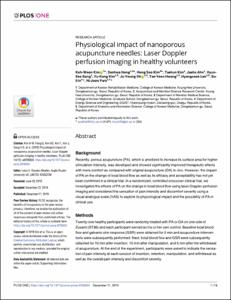Department of Energy Science and Engineering
Green and Renewable Energy for Endless Nature(GREEN) Lab
1. Journal Articles
Physiological impact of nanoporous acupuncture needles: Laser Doppler perfusion imaging in healthy volunteers
- Title
- Physiological impact of nanoporous acupuncture needles: Laser Doppler perfusion imaging in healthy volunteers
- Author(s)
- Kim, Koh-Woon ; Hong, Sanhwa ; Kim, Hong Soo ; Kim, Taehun ; Ahn, Jaeha ; Song, Hyun-Seo ; Kim, Yu-Kang ; Oh, Ju-Young ; Hwang, Tae-Yeon ; Lee, Hyangsook ; In, Su-Il ; Park, Hi-Joon
- DGIST Authors
- Kim, Koh-Woon ; Hong, Sanhwa ; Kim, Hong Soo ; Kim, Taehun ; Ahn, Jaeha ; Song, Hyun-Seo ; Kim, Yu-Kang ; Oh, Ju-Young ; Hwang, Tae-Yeon ; Lee, Hyangsook ; In, Su-Il ; Park, Hi-Joon
- Issued Date
- 2019-12
- Type
- Article
- Article Type
- Article
- Keywords
- GENE-RELATED PEPTIDE ; CONNECTIVE-TISSUE ; NEURAL MECHANISM ; ELECTROACUPUNCTURE ; STIMULATION ; PAIN ; SKIN ; VASODILATATION ; MICRONEEDLES ; AFFERENTS
- ISSN
- 1932-6203
- Abstract
- Background Recently, porous acupuncture (PA), which is anodized to increase its surface area for higher stimulation intensity, was developed and showed significantly improved therapeutic effects with more comfort as compared with original acupuncture (OA) in vivo. However, the impact of PA on the change of local blood flow as well as its efficacy and acceptability has not yet been confirmed in a clinical trial. In a randomized, controlled crossover clinical trial, we investigated the effects of PA on the change in local blood flow using laser Doppler perfusion imaging and considered the sensation of pain intensity and discomfort severity using a visual analogue scale (VAS) to explore its physiological impact and the possibility of PA in clinical use. Methods Twenty-one healthy participants were randomly treated with PA or OA on one side of Zusanli (ST36) and each participant served as his or her own control. Baseline local blood flow and galvanic skin response (GSR) were obtained for 5 min and acupuncture interventions were subsequently performed. Next, local blood flow and GSR were subsequently obtained for 10 min after insertion, 10 min after manipulation, and 5 min after the withdrawal of acupuncture. At the end of the experiment, participants were asked to indicate the sensation of pain intensity at each session of insertion, retention, manipulation, and withdrawal as well as the overall pain intensity and discomfort severity. Results PA significantly increased the local blood flow as compared with OA and there was no significant difference in GSR between patients treated with PA versus OA in each phase of insertion and manipulation. No significant difference in pain intensity or discomfort severity was found during manipulation, retention, or withdrawal of acupuncture. Conclusions These results indicate that PA increases local blood flow, which can be closely related to the observed enhanced performance, without any associated discomfort or pain, suggesting its applicability in clinical practice. © 2019 Kim et al. This is an open access article distributed under the terms of the Creative Commons Attribution License, which permits unrestricted use, distribution, and reproduction in any medium, provided the original author and source are credited.
- Publisher
- Public Library of Science
- Related Researcher
-
-
In, Su-Il
- Research Interests CO2 conversion to hydrocarbon fuels; Water splitting for hydrogen generation; Quantum dot devices; Dye sensitized solar cells; Environmental remediation; Synthesis of functional nanomaterials; CO2 연료전환; 수소생산을 위한 광전기화학적 물분해; 양자점 태양전지; 염료감응 태양전지; 공해물질 저감연구; 기능성 나노소재 개발
-
- Files in This Item:
-
 기타 데이터 / 1.8 MB / Adobe PDF
download
기타 데이터 / 1.8 MB / Adobe PDF
download



